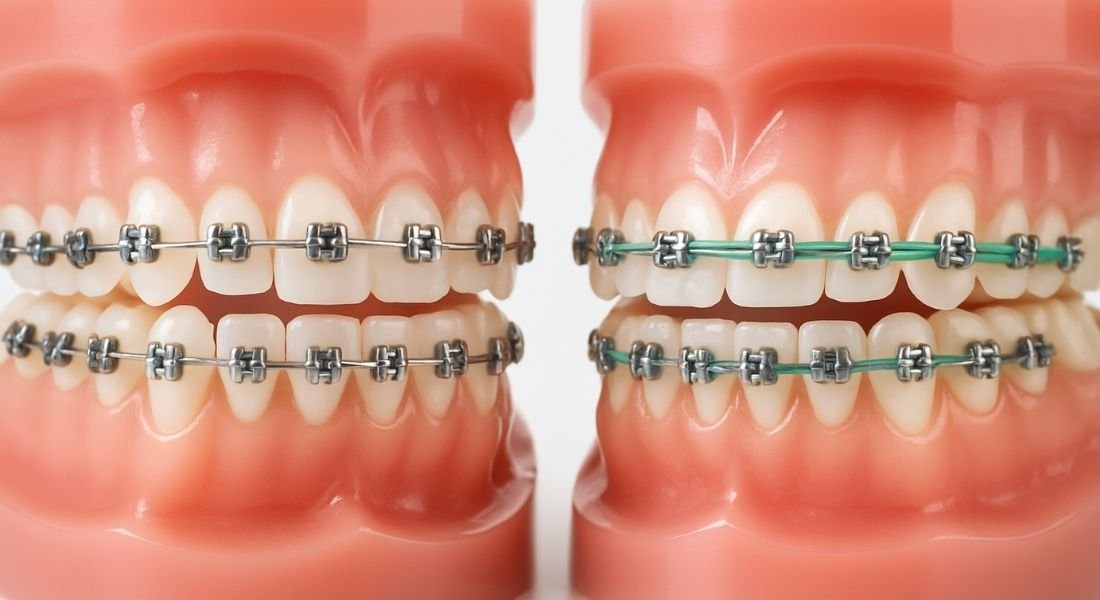If you are wearing braces, you have probably heard your orthodontist mention power chains or Elastic brace chain at some point. These elastic chains might look small, but they play a big role in accelerating the alignment process.
Whether you are just starting your braces journey or you are midway through, understanding power chains can help ease your concerns and set clearer expectations.
In this article, we’ll walk you through everything you need to know about these tooth aligning chains, how they work, their types when they are used and what comes after them. We’ll also answer the most common questions like Do power chains hurt? and Are Elastic brace chain the last step of braces?
What Are Power Chains?
Power chains are a series of connected elastic rings that attach to your braces. Unlike regular ligatures (the small rubber bands placed on each bracket), tooth aligning chain link multiple brackets together. This allows them to apply continuous, gentle pressure across several teeth at once.
They can be made from elastic material or in some rare cases, fine metal. Most Elastic brace chain are stretchy and come in a wide range of colors including the increasingly popular Power Chains Black, often chosen for their discreet appearance.
Orthodontists use these elastic chains for more complex adjustments like closing gaps between teeth, aligning the dental midline or rotating specific teeth. They might be applied at various points during your treatment, depending on your specific orthodontic goals.
Why Power Chains Matter: Benefits and Importance
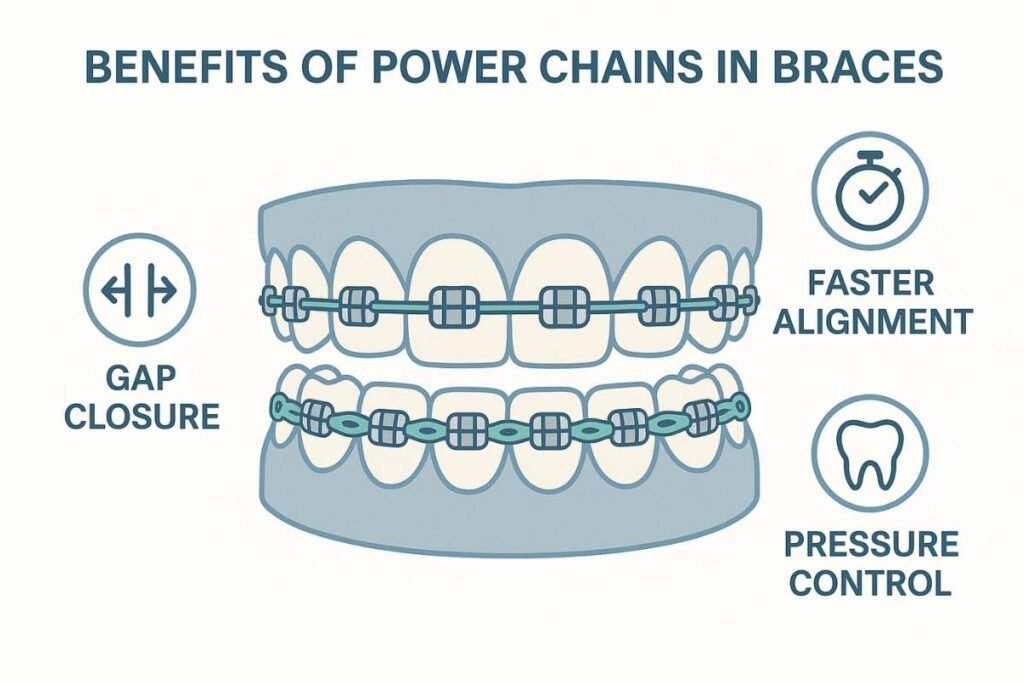
These tooth aligning chains aren’t just an add on, they are a key tool in modern orthodontics. Here is why they matter so much:
They Speed Up Tooth Movement
One of the biggest advantages of this tooth aligning chain is that they work faster than braces alone when it comes to closing gaps.
The elastic chain exerts more concentrated pressure than individual rubber bands, accelerating movement and making treatment more efficient.
They Help Close Gaps and Align Teeth
If you have had a tooth extracted or naturally have gaps between your teeth, they are often used to pull teeth together. This makes them especially useful during the middle or later stages of braces treatment, once your teeth are more mobile.
They Improve Treatment Efficiency
Power chains allow orthodontists to target multiple teeth at once. This means your treatment plan can progress faster without compromising accuracy.
Whether it is for rotating teeth, shifting them into better alignment or correcting bite issues, these chains help streamline the process.
They Offer Customizable Pressure
There are different types of power chains for braces, each offering different levels of force. Depending on your needs, your orthodontist can choose from:
- Closed chains (tight spacing between rings)
- Short chains (slightly spaced)
- Long chains (widely spaced)
This allows for personalized care depending on your unique smile.
How Power Chains Work: A Step by Step Explanation
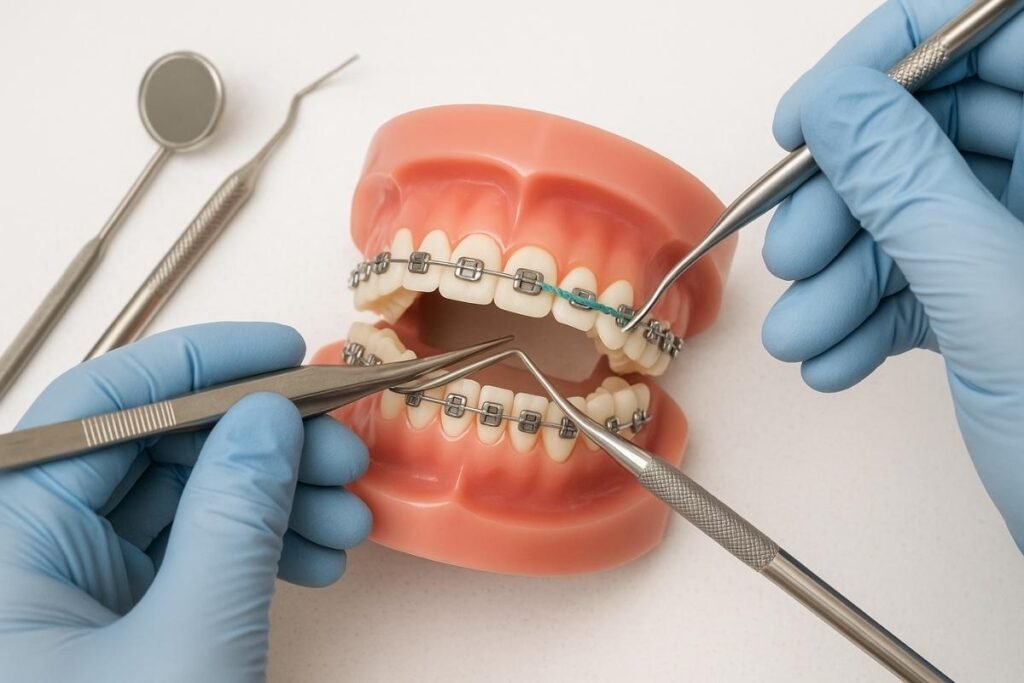
If your orthodontist has said you are getting these tooth aligning chains , here is what to expect:
Removing Regular Ligatures
Your orthodontist will start by removing the individual ligatures (those tiny rubber bands around each bracket). This makes room for the power chain.
Attaching the Power Chain
Next, they’ll cut a length of power chain from a spool, based on how many teeth need to be linked. The elastic chain is then stretched over your brackets, usually over the wire, connecting several teeth together.
Some patients will have chains on just the top or bottom row, while others may need both.
Adjusting for Pressure
Because each chain type (closed, short, long) applies different pressure, your orthodontist will decide the best type for your case. Sometimes, you’ll have these tooth aligning chains and regular ligatures on different parts of your mouth at the same time.
Regular Adjustments
Power chains lose their strength over time, especially as you chew, talk or brush. That’s why they are usually replaced every 4–6 weeks during your braces adjustments.
What to Expect With Power Chains
Let’s answer a few questions you are probably wondering especially if you are about to get power chains for the first time.
Do Power Chains Hurt?
Yes, these tooth aligning chains can cause mild discomfort, especially right after they’re applied or tightened. The pressure is what helps your teeth move, so it’s totally normal to feel sore for a few days.
Most patients describe it as a dull ache or tenderness, especially when biting or chewing. Over the counter pain relief like Tylenol (acetaminophen) can help. Avoid ibuprofen or naproxen if possible, as they may slow down tooth movement.
Power Chains Braces Pain: How Long Does It Last?
Typically, any soreness lasts 2 to 4 days. After that, the discomfort fades as your mouth adjusts. Cold drinks, soft foods and gentle brushing can ease the transition.
Power Chains Before and After: Real Results
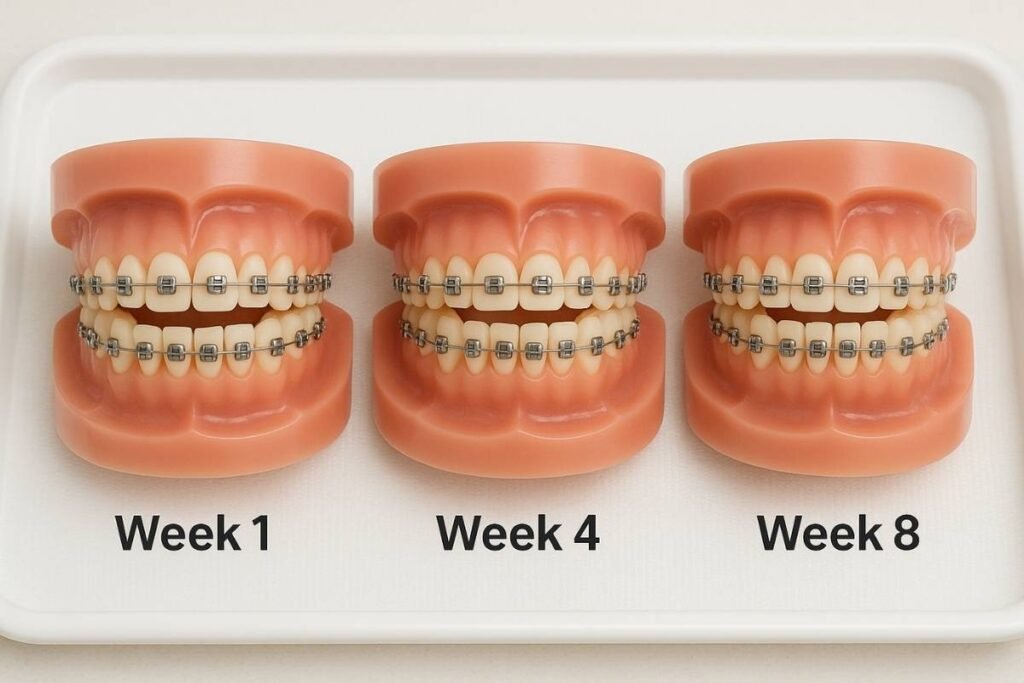
You might not notice major changes in a single week, but over the course of treatment, these tooth aligning chains can dramatically shift your smile. They are especially noticeable in before and after cases involving:
- Diastema (gap between front teeth)
- Post extraction spacing
- Rotated or twisted teeth
Photos often show a noticeable reduction in spacing within 6–8 weeks of using power chains. Results vary, but most patients see continuous improvement with consistent wear and regular adjustments.
Are Power Chains the Last Stage of Braces?
Not always but they are often used toward the middle or end of treatment. Many people assume they come last because they are associated with gap closure and fine tuning alignment.
However, these tooth aligning chains can be introduced at any point depending on your orthodontic goals. Once these tooth aligning chains have done their job, your orthodontist may:
- Switch back to regular ligatures
- Adjust the archwire for final alignment
- Prepare you for the retainer stage, which comes after braces are removed
What Comes After Power Chains?
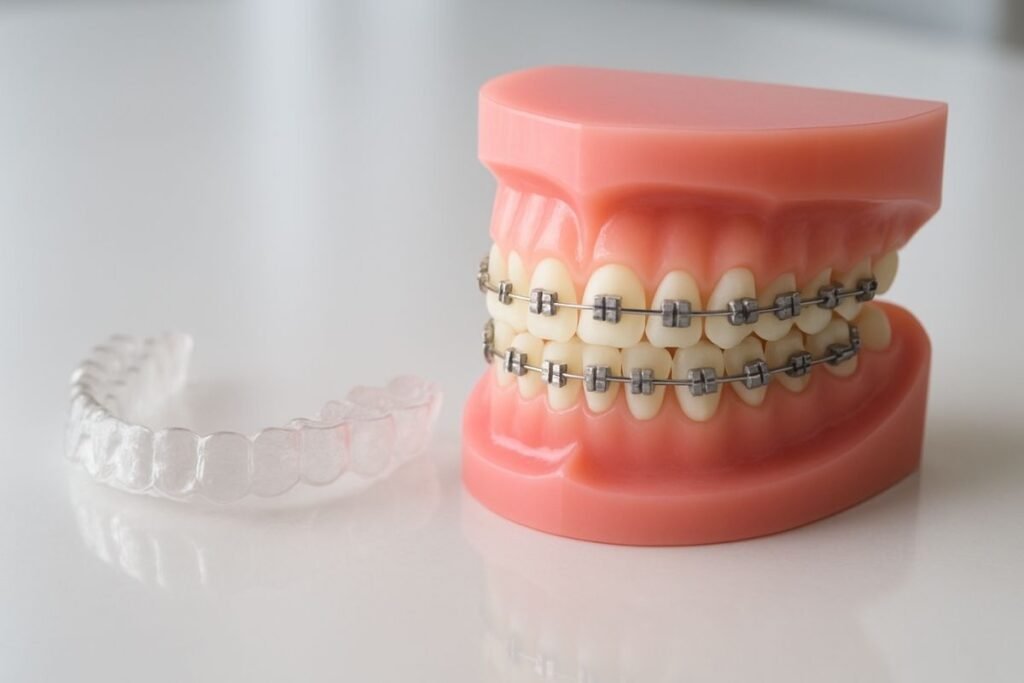
After power chains, your orthodontist may continue fine adjustments using lighter bands or different tools. Eventually, when your teeth are properly aligned, your braces will be removed and you’ll be fitted for a retainer. This is crucial to prevent your teeth from shifting back.
Retainers can be:
- Fixed (permanent) wires behind your teeth
- Removable plastic trays (like Invisalign style retainers)
Whatever comes next, remember: your retainer is just as important as the braces or power chains that got you there.
Conclusion
Power chains are one of the most effective tools in modern orthodontics. They might seem like a small change in your treatment plan, but their impact is huge helping to close gaps, rotate teeth, align your bite and speed up treatment.
While they may cause some discomfort at first, the results they bring are well worth it. Whether you are already wearing power chains or you are just hearing about them for the first time, understanding how they work gives you more confidence and clarity during your braces journey.
And remember, what comes after these tooth aligning chains is just as important, so keep up with your appointments, follow your orthodontist’s advice and you’ll be smiling brighter in no time.
FAQs
What does it mean when you get power chains?
It usually means your orthodontist is ready to close gaps, apply more pressure or make specific adjustments to the alignment of your teeth. These tooth aligning chain help speed up these changes more efficiently than standard braces alone.
Are power chains the last step of braces?
They can be, but not always. While these tooth aligning chains are often used toward the final stages of treatment, they may also be introduced earlier depending on your needs.
Do everybody with braces get power chains?
No, not everyone. These tooth aligning chains are typically used for specific goals like closing gaps or rotating teeth. If your teeth are mostly aligned or your orthodontic case is mild, you might never need them.
Do power chains work faster than braces?
These tooth aligning chains don’t replace braces bur they work with them to increase the speed and efficiency of certain movements. In cases where space closure or alignment needs extra force, power chains can deliver faster results.
Power Chains vs Braces: What’s the Difference?
Braces are the full system with brackets, archwire and ligatures. These tooth aligning chains are add ons used to boost certain functions, like gap closure or alignment. Think of them as a performance upgrade to standard braces.
Can I pick the color of my power chains?
Yes! Just like ligatures, these tooth aligning chains come in many colors. Some people go bold with pink, blue or green, while others prefer Power Chains Black for a more subtle, mature look.

